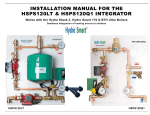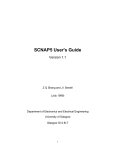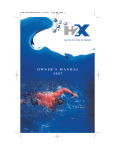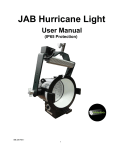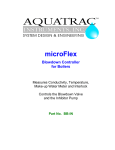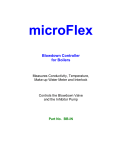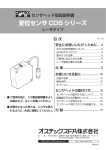Download Shark 7.2 VDC Technical data
Transcript
PHONE: 800-355-4945 EMAL: [email protected] WEB: www.energyproducts.biz HYDRO-SHARK 3 ® MODULATING MICRO BOILERS Radiant Floor Heating Applications INSTALLATION INSTRUCTIONS FOR THE LICENSED PLUMBER & ELECTRICAN MODEL #’S: MODEL #’S: MODEL #’S: • SH3-07 • SH3-10 • SH3-12 • SH3-14 • SH3-19 • SH3-24 • SH3-29 • SH3-36 Warning: Not to be used with potable water systems 1 PHONE: 800-355-4945 EMAL: [email protected] WEB: www.energyproducts.biz Table of Contents Important 3 General 3 4-5 Mounting the units 6 Fluid connections 7-9 Electrical connections Technical data 10 Troubleshooting 11 Spare parts 11 Warranty 12 Electrical & Mechanical Diagrams 13-19 Filling the System 20-23 2 PHONE: 800-355-4945 EMAL: [email protected] WEB: www.energyproducts.biz IMPORTANT! BOILERS ARE TO BE USED FOR RADIANT FLOOR HEATING ONLY! THIS MANUAL MUST BE READ CAREFULLY BEFORE ATTEMPTING TO INSTALL THE HYDRO-SHARK BOILERS. IF YOU DO NOT FOLLOW THE SAFETY RULES OR THE INSTRUCTIONS OUTLINED IN THIS MANUAL, THE UNIT MAY NOT OPERATE PROPERLY AND IT COULD CAUSE PROPERTY DAMAGE, SERIOUS BODILY INJURY AND/OR DEATH. STIEBEL ELTRON, INC. WILL NOT BE LIABLE FOR ANY DAMAGES BECAUSE OF FAILURE TO COMPLY WITH INSTALLATION AND OPERATING INSTRUCTIONS OUTLINED IN THIS MANUAL OR BECAUSE OF IMPROPER USE. IMPROPER USE INCLUDES THE USE FOR THIS APPLIANCE TO HEAT ANY LIQUID OTHER THAN WATER OR PROPYLENE GLYCOL. FALURE TO COMPLY WITH THE INSTALLATION AND OPERATING INSTRUCTIONS OR IMPROPER USE VOIDS THE WARRANTY. NEVER REMOVE THE UNITS FRONT COVER UNLESS POWER IS TURNED OFF. IF YOU HAVE ANY QUESTIONS REGARDING THE INSTALLATION OR OPERATION OF THES BOILER, PLEASE CALL OUR TECHNICAL SERVICE LINE AT 800-582-8423 (U.S.A. AND CANADA ONLY). IF YOU ARE CALLING OUTSIDE OF THE U.S. AND CANADA CALL (413)-538-7850 AND WE WILL REFER YOU TO A QUALIFIED STIEBEL ELTRON SERVICE REPRESENTATIVE IN YOUR AREA. GENERAL • The output of heat from the boiler is electronically controlled. The Boiler will deliver any water tempeture between 86° F and 140° F for the SH3-12,SH3-14, SH3-19, SH3-24, SH3-36 and 120° F for the SH3-07 and SH3-10. Please set the desired water delivery tempeture using the knob on the front cover. • When the Power light is flashing, full element power is being applied. When the Power light is not flashing, the element power is being modulated to the water delivery temperature. • Recommended Setting for radiant floor heating in cement or gypcrete is 110° F to 125° F. • Recommended Setting for staple up or baseboard 140° F. 3 PHONE: 800-355-4945 EMAL: [email protected] WEB: www.energyproducts.biz MOUNTING THE UNIT SH3-12, SH3-14, SH3-19, SH3-24, SH3-29 & SH3-36 UNIT MUST BE INSTALLED IN A VERTICAL POSITION WITH THE WATER FITTINGS POINTING DOWNWARD, DO NOT INSTALL UNIT WHERE IT WOULD ROUTINELY BE SPLASHED WITH WATER OR ELECTRICAL SHOCK MAY RESULT. 1. Leave a minimum of 5” of Clearance on all sides for servicing. 2. Make sure that the Power is Off. 3. Remove the Cover. 4. Mount securely to wall by putting four screws through mounting holes. 5. Screw and plastic wall anchors for mounting on masonry or wood are provided. 4 PHONE: 800-355-4945 EMAL: [email protected] WEB: www.energyproducts.biz MOUNTING THE UNIT SH3-3 & SH3-10 UNIT MUST BE INSTALLED IN A VERTICAL POSITION WITH THE WATER FITTINGS POINTING DOWNWARD, DO NOT INSTALL UNIT WHERE IT WOULD ROUTINELY BE SPLASHED WITH WATER OR ELECTRICAL SHOCK MAY RESULT. 1. Leave a minimum of 5” of Clearance on all sides for servicing. 2. Make sure that the Power is Off. 3. Remove the Cover. 4. Mount securely to wall by putting four screws through mounting holes. 5. Screw and plastic wall anchors for mounting on masonry or wood are provided. 5 PHONE: 800-355-4945 EMAL: [email protected] WEB: www.energyproducts.biz FLUID CONNECTIONS NOTE: EXCESSIVE HEAT FROM SOLDERING COPPER PIPES NEAR THE BOILER MAY CAUSE DAMAGE. 1. All plumbing work must comply with the national, state, local & any other applicable codes. 2. Make sure the radiant floor system has been purged & is free of floating debris. 3. The return side (inlet) is on the right side of the unit, the supply side (outlet) is on the left of the unit. 4. A pressure & temprature relief valve should be installed on the hot water supply side (outlet) of the unit. 5. The boiler is designed for a connection to copper tubing and/or PEX tubing. If soldering the unit is necessary, please direct the flame away from the housing of the unit to avoid damage. 6. When all plumbing work is completed, check for leaks & take corrective action before proceeding. SUPPLY OUTLET RETURN INLET 6 PHONE: 800-355-4945 EMAL: [email protected] WEB: www.energyproducts.biz ELECTRICAL CONNECTIONS WARNING: BEFORE BEGINNING ANY WORK ON THE ELECTRIC INSTALLATION, BE SURE THAT THE MAIN BREAKER PANEL SWITCHES ARE “OFF” TO AVOID ANY DANGER OF ELECTRIC SHOCK. ALL MOUNTING AND PLUMBING MUST BE COMPLETED BEFORE PROCEEDING WITH ELECTRICAL HOOK-UP. WHERE REQUIRED BY LOCAL,STATE OR NATIONAL ELECTRICAL CODES THE CIRCUITS SHOULD BE EQUIPPED WITH A “ GROUND FAULT INTERRUPTER”. 1. All electrical work must comply with the national, state, local & any other applicable codes. 2. The boiler should be connected to properly grounded dedicated branch circuits of proper voltage rating. Ground must be brought to the ‘Ground’ at the circuit breaker panel. 3. A SH3-07, SH3-10 & SH3-12 can be connected to ONE independent circuit (Figure A & B). 4. A SH3-14, SH3-19 & SHE-24 can be connected to TWO independent circuits (Figure C). Use supply table (See Technical Data table “A” on page XX). Protected by TWO double pole breakers sized for the load. 5. A SH3-29,SH3-36 can be connected to THREE independent circuits (Fig D.). Use supply cable (See Technical Data Table “A”) protected by THREE double pole breakers sized for the load. 6. Cut the electrical connection cable to length and strip. 7. The wire must be fed through the knockouts located between the Supply and Return fluid connections. The “Live” wires must be connected to the slots on the terminal block marked “L” and “L”. The ground wire must be connected to slot marked with the ground symbol. 8. Reinstall the cover screws. WARNING! As with any electrical appliance, failure to electrically ground may result in serious injury or Death. 7 PHONE: 800-355-4945 EMAL: [email protected] Figure A SH3-07 & SH3-10 Figure B SH3-12 8 WEB: www.energyproducts.biz PHONE: 800-355-4945 EMAL: SH3-29,SH3-36 SH3-36 SH3-24 [email protected] SH3-14,SH3-19,SH3-24 WEB: www.energyproducts.biz SH3-12 SH3-29 SH3-14, SH3-19 9 SH3-12 PHONE: 800-355-4945 EMAL: [email protected] WEB: www.energyproducts.biz TECHNICAL DATA “A” MODEL - 14 1/4 H X 7 7/8 W X 4 1/8 D - 1/2 PLUMBING FITTINGS MODEL KW BTU VOLTS AMPS BRKR WT-LBS SH3-07 7.2 24,573 240 30 (1)40 5.9 SH3-10 9.6 32,764 240 40 (1)50 5.9 “B” MODEL - 14 1/2 H X 16 5/8 W X 4 5/8 D - 3/4 PLUMBING FITTINGS MODEL KW BTU VOLTS AMPS BRKR WT-LBS SH3-12 12 40,968 240 50 (1)70 17 SH3-14 14.4 49,161 240 60 (2)40 20 SH3-19 19.2 65,548 240 80 (2)50 20 SH3-24 24 81,936 240 100 (2)70 20 “C” MODEL - 14 1/2 H X 16 5/8 W X 4 5/8 D 3/4 PLUMBING FITTINGS MODEL KW BTU VOLTS AMPS BRKR WT-LBS SH3-29 28.8 98,323 240 120 (3)50 24 SH3-36 36 122,904 240 150 (3)70 24 NOTE: 1. Boilers are considered a continuous load. 2. Copper conductors only. SERVICE BULLETIN: Polarity matters on the Hydro-Shark Models with multiple circuits. On models Sh3-14,19,24,29 and 36 the polarity of L1/L2 maters. If the installer places L1 on the left side of circuit 1, than L1 has to be placed on the left side of circuit 2 (SH3-14,19,24) and circuit 3 (SH3-29,36). It does not matter if L1 or L2 is placed on the left or right side on the wireing block. It only maters that all circuits are wired consistently, with L1 either always on the left or always on the right. If the boiler will not run, reverse the L1 and L2 wires on one or two of the wiring block to make the “polarity” consistent. The Factory is making changes to the interior wiring so that the L1/L2 Polarity will not mater in the future. -May 14,2009 10 PHONE: EMAL: 800-355-4945 WEB: [email protected] www.energyproducts.biz TROUBLE SHOOTING SYMPTOM POSSIBLE CAUSE SOLUTION NO HOT WATER • No Power • Safety thermal cut-off tripped • Not enough flow rate to activate unit • Plugged flow sensor • Utility Controlling Load • Reset Thermal cut-off • Wrong size Pump • Activate thermostat • Clean flow sensor WATER NOT HOT ENOUGH • Water flow too high • Voltage too low • Glycol/water ratio to high • Manifold or Ball Valve Closed • Reduce water flow rate • Supply correct voltage to unit • More than 20% less than 50% • Open Loops/Ball Valve LEDS DO NOT LIGHT • Problem with electronic controls • Contact Energy Products,Inc. 1-763-441-8303 SPARE PARTS Hydro-Shark 07 Hydro-Shark 10 Hydro-Shark 12 Hydro-Shark 14 Hydro-Shark 19 Hydro-Shark 24 Hydro-Shark 29 Hydro-Shark 36 1 2 3 4 5 6 Saftey thermal cut out Flow Sensor Electronic control unit Housing Electronic Setpoint selector Heating System 170305 170302 170307 170303 170305 170302 170307 170304 286369 256461 286366 286356 286359 286360 286369 256461 286365 286356 286359 286361 286369 256461 286844 286356 286359 286362 286369 256461 286367 286356 286359 286364 286369 256461 286378 286370 286372 286373 286369 256461 286379 286370 286372 286374 11 PHONE: 800-355-4945 EMAL: [email protected] WEB: www.energyproducts.biz WARRANTY RESIDENTIAL & COMMERCIAL WARRANTY: STIEBEL-ELTRON WARRANTS TO THE ORIGINAL OWNER THAT ALL BOILERS (SH3-SERIES) WILL BE FREE FROM DEFECTS IN WORKMANSHIP AND MATERIALS FOR A PERIOD OF THREE YEARS FROM THE DATE OF PURCHASE. SHOULD THE PART(S) PROVE TO BE DEFECTIVE UNDER NORMAL USE DURING THIS PERIOD STIEBEL-ELTRON, INC. WILL BE RESPONSIBLE FOR THE REPLACEMENT OF THE DEFECTIVE PART(S) ONLY. STIEBEL-ELTRON,INC. IS NOT RESPONSIBLE FOR LABOR CHARGES TO REMOVE AND OR REPLACE THE DEFECTIVE PART(S), OR ANY INCIDENTIAL OR CONSEQUENTIAL EXPENSES. SHOULD THE OWNER WISH TO RETURN THE BOILER FOR REPAIR, THE OWNER MUST FIRST SECURE WRITTEN AUTHORIZATION FROM STIEBEL-ELTRON, INC. THE OWNER SHALL BE REQUIRED TO SHOW PROOF OF PURCHASE DATE AND PAY ALL TRANSPORTATION COSTS TO RETURN THE DEFECTIVE PART(S) OR BOILER FOR REPAIR OR REPLACEMENT. WARRANTY IS VOID IF BOILER HAS BEEN INSTALLED OR USED IMPROPERLY OR IF DESIGN HAS BEEN ALTERED IN ANYWAY. ENERGY PRODUCT SUPPLY GROUP INC. 10725 165TH AVENUE NORTH WEST • ELK RIVER, MINNESOTA 55330 PHONE: 763-441-8303 FAX: 763-4241-9628 EMAIL: [email protected] 12 PHONE: 800-355-4945 EMAL: [email protected] 13 WEB: www.energyproducts.biz PHONE: 800-355-4945 EMAL: [email protected] 14 WEB: www.energyproducts.biz PHONE: 800-355-4945 EMAL: [email protected] 15 WEB: www.energyproducts.biz PHONE: 800-355-4945 EMAL: [email protected] 16 WEB: www.energyproducts.biz PHONE: 800-355-4945 EMAL: [email protected] 17 WEB: www.energyproducts.biz PHONE: 800-355-4945 EMAL: [email protected] 18 WEB: www.energyproducts.biz PHONE: 800-355-4945 EMAL: [email protected] 19 WEB: www.energyproducts.biz PHONE: 800-355-4945 EMAL: [email protected] WEB: www.energyproducts.biz FILLING THE SYSTEM The pH of a system is a measure of the hydrogen concentration. The higher the reading the more basic the solution, the lower the PH the more acidic the solution. The pH scale ranges from 1-14 with a ph of 7 being neutral. The proper pH of a system can have a great effect on the overall life of the system. The pH of a system should be kept between 9 and 10.5 for optimum operational life. Less than a 9pH will corrode steel and a higher than 10.5 will corrode brass and copper. High pH will cause precipitation of iron from the water that will cause corrosion in the system. Buffers and inhibitors can help maintain the proper pH range. System can be sick and show up in a change of the pH. A bacterial infection from injection water and other sources can produce an acidic byproduct which will drop the pH. This can be combated with the addition of a biocide. As glycol degrades, it produces acidic byproducts that drop the pH. The system needs to be maintained annually by monitoring the pH of the solution with a pH meter or test strips making adjustments as needed. There are different types of bacteria that can infect a system. Bacterial infections are not often seen but occasionally appear. They can take the form of slimy goo to looking like little paint chips they can plug the heat chambers on the heat unit. Bacteria can thrive in a glycol environment that has less than a 20% Glycol. At this lower concentration the glycol is no longer toxic to the bacteria and actually acts as food for it. Bacteria can leave a slime residue that interferes with the operation of the system. The excrement of the bacteria can be highly corrosive, as indicated by pin-hole leaks in the system. If an infection is found, the best way to remove it is to add dispersants and a biocide to the system. Glycol and water mix should be over 20% and under 50% adjusted for your local tempeture protection. Conductivity is a indirect measurement of total dissolved solids in the water. Domestic tap water has a conductivity of about 300 uS/cm The conductivity in a closed loop hydronic heating system should be between 700 and 3200uS/cm depending on which additives are in the water. Addition of glycol, nitrite and even soft water will have an effect on the amunt of disolved solids in the water. Conductivity above 3500uS/cm indicates a high level of dissolved solids water with large amunts of dissolved solids becomes physically aggressive and can breakdown o-rings. Systems above 3500 uS/cm should be flushed and refilled with fresh water/glycol and if required corrosion inhibitors. The “Old School” of water quality recommended distilled, or soft water in closed loop systems. It was thought that the precipitation of CaCo, needed to be controlled. It is now recommended that hard water can be used. The reason for change is that softened and distilled water has the natural mineral balance disturbed. The disturbed water will try to re-balance itself by leaching the minerals from the metals in the water and from the system itself. The leaching of minerals from the metal will cause a higher rate of corrosion. To help combat the precipitation of CaCo, with out softening the water, dispersants are included in the corrosion inhibitor mixtures that keep the CaCo in the water. A concern arises with respect to hardness in well water. Well water is very hard and in some cases up to 60 grains/USG or 1026ppm. In some areas it also has bacteria as well as hardness. In cases of extreme hardness it is better to use city water. 20 PHONE: 800-355-4945 EMAL: [email protected] I. FILLING THE SYSTEM A. System is assembled, it is time to fill it. WEB: www.energyproducts.biz OVERVIEW OF A TYPICAL SYSTEM B. Fill the system until there are no air bubbles in it. Air bubbles cause circulator pumps and element failures. C. Purge the system one loop at a time. Open one loop with all of the other loops closed repeat down the manifold. Purge each loop untill no air is seen in the discharge/fill tank. II. SOLUTION A. The solution should be polypropylene glycol and city water NOT: RV anit-freeze - it is for non moving solutions and breaks down; automotive antifreeze - it is Toxic; well water - there is a bacteria in well water that in the presence of glycol and heat can turn into a bio-film, coat elements and plug up the boiler. B. The mixture should contain more than 20% but less than 50% pure glycol. Increased glycol precentages increases the head pressure of the system. Proper flows through the system may not be reached as a result the boiler may not work; too little glycol promotes bacteria growth. III. ATTACH HOSES A. Obtain 3 washing machine hoses, one 20 gallon tub for mixing, and a transfer pump 1/2 HP or larger (not a sump-pump or a submersable pump) 1. Put one of the hoses into the mixing tub attach the other end to the intake of the fill pump. 2. Attach the second hose (red) to the discharge side of the pump and attach the other end to “A” the bottom gate valve on the lowerflange of the primary circulator. The gate valve “A” should be in the open position while filling. 3. The ball valve on the lower Webstone flange should be in the Open position at this time. The ball valve handle “B” should be in line with the tubing. 21 PHONE: 800-355-4945 EMAL: [email protected] 4. Attach the third hose (blue) to valve “C” located above the primary circulator. Put the other end into the fill tub. This valve “C”should be open allowing water to circulate through the floor and all of the loops back to the bucket where it started. The bucket must have fluid in it at all times while filling. As the water returns the fluid may be milky, this is air in the solution. The fluid must be circulated until all air is removed and the water runs clear. WEB: www.energyproducts.biz FILLING HOSE CONNECTIONS 5. The ball valve “D” located on the upper flange should be closed during filling and Open when in operation. 6. If this is a primary/secondary system (2 pumps on the main panel) the purge valve should be in the vertical position “E” while filling. This forces the fluid through the floor, and prevents flow to the primary loop during the filling process. After the system is filled make sure that the purge valve “E” is open and in a horizontal position. Note: If you have a Caleffi differential by-pass kit on your manifold you need to attach the fill hose to “C” and the discharge hose to”A’. This reverses the flow and allows you to still purge each loop individually and not open the by pass while filling. IV. DOMESTIC WATER FORCED FILL A. Domestic water forced fill procedure E 1. Attach the fill hose to the domestic city water supply, attach the other end to the gate valve”A” on the bottom flange of the primary circulator. 2. Attach the discharge hose to the gate valve “C” on the upper flange of the primary circulator. The other end of the discharge hose should be submerged in water prior to going into a drain. 3. Fill the system, watch for air bubbles in the discharge water. 4. Open each loop individually so the air can be purged from each loop separately. Watch your tub to see if any air bubbles are coming out of the solution while filling. 5. When no bubbles are seen, close the discharge line. When the pressure comes to 15-25 lbs, turn off the fill valve and shut off the water. 22 PHONE: 800-355-4945 EMAL: WEB: [email protected] www.energyproducts.biz V. FINISH FILLING A. Water has turned from milky to clear. B. NO air bubbles are seen. C. Close the discharge ball valve. D. Keep pumping until pressure on the guage is 15-20 Lbs. E. Turn off the fill valve. F. Shut off the pump, the system should be free of air and at pressure. VI. PRESSURE MAINTENANCE SYSTEMS FOR CLOSED LOOP SYSTEMS (Recommended) A. Limited volume and unlimited volume 1. Use an Axiom system feeder for a pressure maintance system that has a limited reserve. Limits any leak to 3 gallons. 2. Household water auto fill system. This is attached to the house water supply and has unlimited water flow. It has a pressure maintance valve and a backflow preventer. 3. Must be either treated city water or a polypropylene glycol mix. 4. Either systems can be attached to the upper right fitting on the Flex-Pro panel for pressure maintance. FILLING THE SYSTEM SYSTEM IN OPERATION 23























